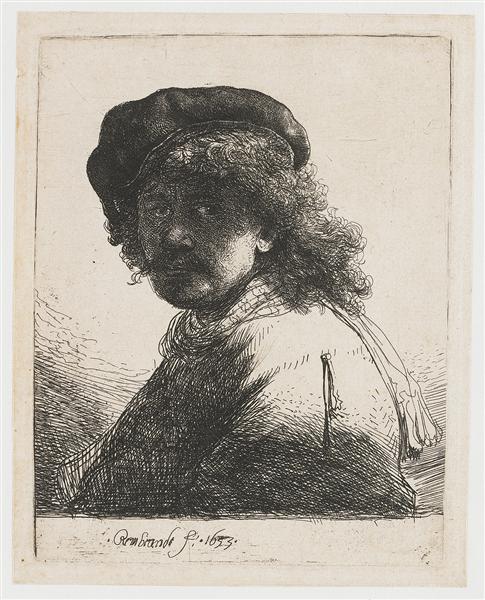Description
Rembrandt’s painting “Self-Portrait with Cap and Scarf and Dark Bust Face,” painted in 1633, is a fascinating work that encapsulates not only the painter’s technical mastery but also a deep psychological introspection that has become characteristic of his numerous self-portraits. In this work, the artist presents himself in an almost monumental format, highlighting his face in a shading that plays with the contrasts of light and shadow, a technique known as chiaroscuro. This manipulation of light not only brings depth to the portrait, but also seems to hint at a complex emotional state, a distinctive feature of Rembrandt’s portraits.
The use of colour in this self-portrait is sublime. Rembrandt employs a palette that relies heavily on dark, earthy tones, giving the work a sense of gravity and seriousness. The hues in the background fade into near-blackness, while the light falling on his face and upper bust creates a spotlight that draws the viewer in, guiding them towards the expression subtly captured in his eyes. The cap he is wearing, along with the scarf tied around his neck, evokes typical clothing of the period, connecting the viewer to the historical context of 17th century Holland.
As a master of self-portraiture, Rembrandt explores in this work not only his physical appearance, but also his identity and personal experience. This self-portrait is particularly significant because it was painted at a period when the artist was beginning to experiment with the use of shadows, breaking with the portrait conventions of his time that tended to emphasize a more luminous and uniform use of color. In this sense, the work is sheltered in innovation, prefiguring a movement that would later give emotional and psychological weight to the expressions portrayed.
This self-portrait also sits within a series of Rembrandt's earlier works, where he presents himself as the protagonist of his own visual narrative. He painted further self-portraits in the same year, revealing his continuing interest in self-examination and representation. However, each self-portrait brings new layers of complexity to the artist's personality, emphasising differences in technique and emotion that invite the viewer to gain an introspective insight through Rembrandt's own gaze.
Furthermore, the context in which Rembrandt created this work is crucial to understanding its impact. In the 1630s, the artist was at the height of his career, enjoying a surge in demand for portraits. This work is not only a testament to his technical skill, but also to his desire to explore the human condition through his own being, which figured prominently in his work throughout his life.
In conclusion, Rembrandt’s Self-Portrait with Cap and Scarf and Dark Bust Face is more than just a portrait. It is a work that encapsulates its creator’s artistic innovations, his mastery in the use of color and light, and his profound ability to reflect human emotional complexity. Each glance at the canvas offers us a new opportunity to contemplate not only the artist, but the very nature of identity and introspection, making this piece an essential work in the study of Baroque art and self-portraiture as a form of self-understanding.
KUADROS ©, a famous painting on your wall.
Hand-made oil painting reproductions, with the quality of professional artists and the distinctive seal of KUADROS ©.
Painting reproduction service with satisfaction guarantee. If you are not completely satisfied with the replica of your painting, we will refund 100% of your money.

